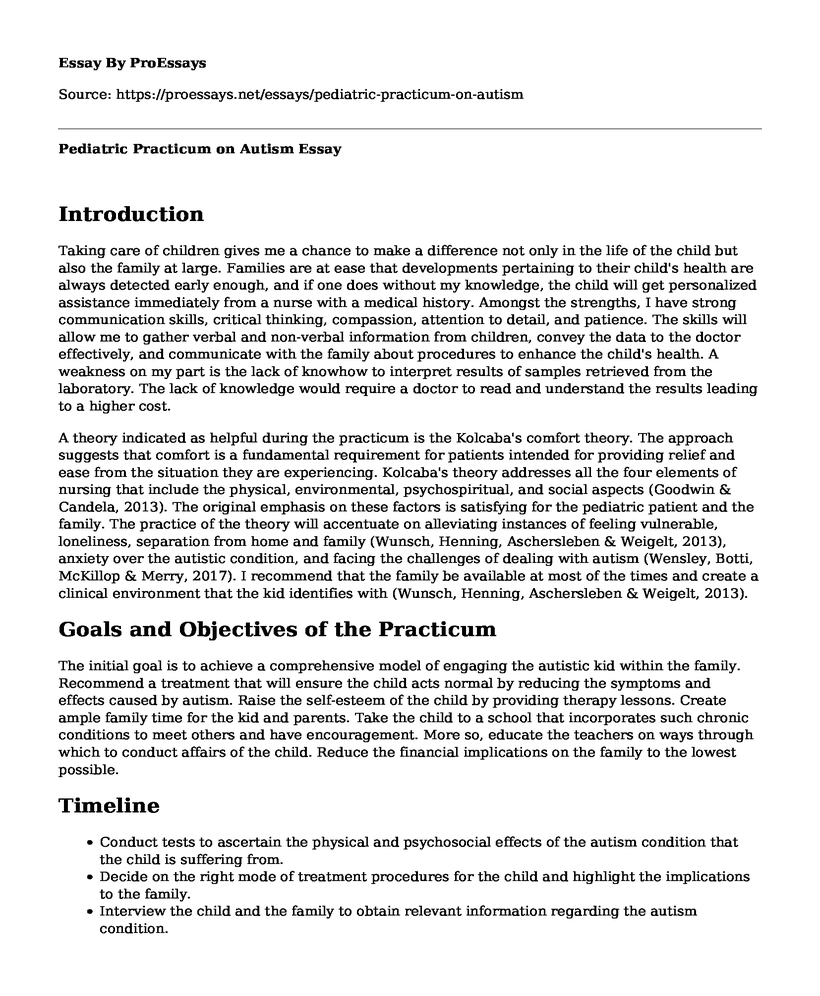Introduction
Taking care of children gives me a chance to make a difference not only in the life of the child but also the family at large. Families are at ease that developments pertaining to their child's health are always detected early enough, and if one does without my knowledge, the child will get personalized assistance immediately from a nurse with a medical history. Amongst the strengths, I have strong communication skills, critical thinking, compassion, attention to detail, and patience. The skills will allow me to gather verbal and non-verbal information from children, convey the data to the doctor effectively, and communicate with the family about procedures to enhance the child's health. A weakness on my part is the lack of knowhow to interpret results of samples retrieved from the laboratory. The lack of knowledge would require a doctor to read and understand the results leading to a higher cost.
A theory indicated as helpful during the practicum is the Kolcaba's comfort theory. The approach suggests that comfort is a fundamental requirement for patients intended for providing relief and ease from the situation they are experiencing. Kolcaba's theory addresses all the four elements of nursing that include the physical, environmental, psychospiritual, and social aspects (Goodwin & Candela, 2013). The original emphasis on these factors is satisfying for the pediatric patient and the family. The practice of the theory will accentuate on alleviating instances of feeling vulnerable, loneliness, separation from home and family (Wunsch, Henning, Aschersleben & Weigelt, 2013), anxiety over the autistic condition, and facing the challenges of dealing with autism (Wensley, Botti, McKillop & Merry, 2017). I recommend that the family be available at most of the times and create a clinical environment that the kid identifies with (Wunsch, Henning, Aschersleben & Weigelt, 2013).
Goals and Objectives of the Practicum
The initial goal is to achieve a comprehensive model of engaging the autistic kid within the family. Recommend a treatment that will ensure the child acts normal by reducing the symptoms and effects caused by autism. Raise the self-esteem of the child by providing therapy lessons. Create ample family time for the kid and parents. Take the child to a school that incorporates such chronic conditions to meet others and have encouragement. More so, educate the teachers on ways through which to conduct affairs of the child. Reduce the financial implications on the family to the lowest possible.
Timeline
- Conduct tests to ascertain the physical and psychosocial effects of the autism condition that the child is suffering from.
- Decide on the right mode of treatment procedures for the child and highlight the implications to the family.
- Interview the child and the family to obtain relevant information regarding the autism condition.
- Administer psychological tests to assess the:
- IQ.
- Child's achievement and capabilities.
- Behavioral traits.
- Retrieve relevant information regarding:
- The patient history from previous medical charts.
- Current medication and treatment.
- Assess the risks of the autism dysfunction.
- Communicate results.
- Start diagnosis and intervention plans.
- Consider their implications on:
- Academic achievement.
- Social life.
- Family.
- Draft recommendations.
- Translate results and recommendations into practical sessions.
- Use supervision in implementing recommendations.
- Conduct continuous clinical and psychological assessments.
References
Goodwin, M., & Candela, L. (2013). Outcomes of newly practicing nurses who applied principles of holistic comfort theory during the transition from school to practice: A qualitative study. Nurse education today, 33(6), 614-619.
Wensley, C., Botti, M., McKillop, A., & Merry, A. F. (2017). A framework of comfort for practice: An integrative review identifying the multiple influences on patients' experience of comfort in healthcare settings. International Journal for Quality in Health Care, 29(2), 151-162.
Wunsch, K., Henning, A., Aschersleben, G., & Weigelt, M. (2013). A systematic review of the end-state comfort effect in normally developing children and in children with developmental disorders. Journal of Motor Learning and Development, 1(3), 59-76.
Cite this page
Pediatric Practicum on Autism. (2022, Jul 25). Retrieved from https://proessays.net/essays/pediatric-practicum-on-autism
If you are the original author of this essay and no longer wish to have it published on the ProEssays website, please click below to request its removal:
- Argumentative Essay on Key Reasons Teenagers Should not Vape
- Child Abuse and Neglect in New York City - Essay Sample
- Exploring Love: Erotic vs. Agape Love - Essay Sample
- El Salvador's Abortion Laws: When Is It Right to Legalize? - Essay Sample
- Evidence-Based Nursing Care for an 80-Year-Old Patient with Osteoarthritis - Essay Sample
- Music: Art of Meaningful Sounds, Universal & Essential - Research Paper Example
- Gifted and Talented - Free Essay Sample







